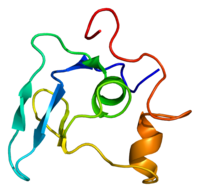
Photo from wikipedia
Interest in primary cilia has increased dramatically over the last ten years as it has become clear that ciliopathies are an underlying cause of numerous human diseases including some types… Click to show full abstract
Interest in primary cilia has increased dramatically over the last ten years as it has become clear that ciliopathies are an underlying cause of numerous human diseases including some types of retinitis pigmentosa and polycystic kidney disease. Once thought to be restricted to a few cell types, it is now clear that primary cilia are found on almost all vertebrate cells and are critical to Sonic hedgehog (Shh) signaling. Mouse models play a key role in developing our understanding of the role of primary cilia in control of Shh signaling in development throughout the embryo and in ongoing maintenance of structures such as photoreceptors. To maximize the utility of the wealth of experimental data generated by these mouse ciliopathy models, we have initiated a project to comprehensively annotate ciliary genes of the laboratory mouse using Gene Ontology (GO) terms to describe their molecular functions, biological roles, and cellular locations. We are guided by the SysCilia gold standard of known human ciliary components as a starting point, but will also include additional genes experimentally shown to be involved in ciliary function in the mouse. If needed, we will also update the Gene Ontology to add new terms representing recent advances in our understanding of ciliary biology. Comprehensive GO annotation of ciliary genes in the mouse will be a great resource to those doing high throughput studies or comparative genomic analysis across species, and may help us better understand the similarities and differences between mouse and human in the role of Sonic hedgehog signaling in development. This work is funded by HG 002273 to the Gene Ontology Consortium. GENEONTOLOGY Unifying Biology ID Mapping at hYp://www.uniprot.org/ 307 mouse genes on cilia candidate list AddiHonal research for human gene with no mouse homologs via MouseMine IdenHficaHon of mouse homologs with MouseMine -‐ hYp://www.mousemine.org/
Journal Title: F1000Research
Year Published: 2017
Link to full text (if available)
Share on Social Media: Sign Up to like & get
recommendations!